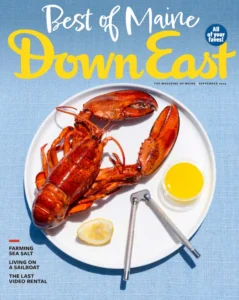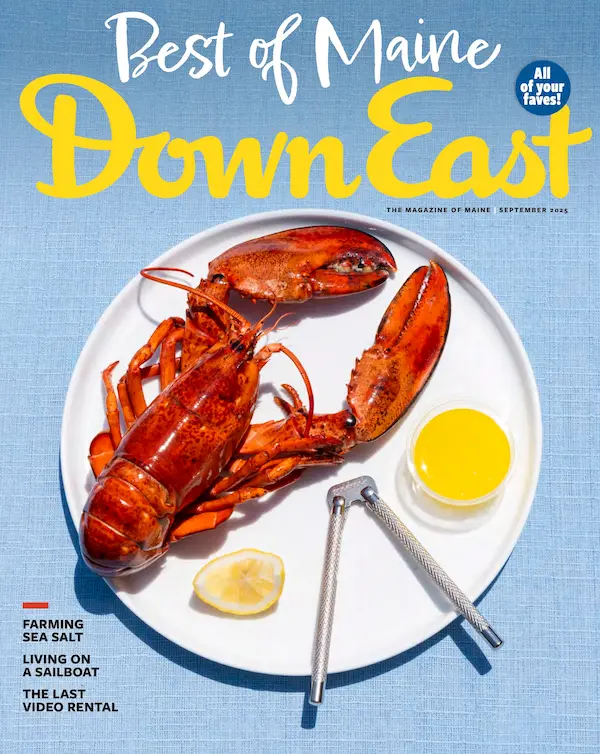By Sara Anne Donnelly
Photos by Ryan David Brown
From our May 2024 issue
Blue Butterfield’s new memoir Maine: A Love Story, composed of 32 essays illustrated with her woodcut prints, is at its most vivid when she trains her eye on her estranged father. “My father was a runaway train,” the Portlander writes in the book’s keystone essay, “How to Make a Reduction Woodcut,” which juxtaposes a story about her dad being hit by a car while riding his bike on the eve of her sixth birthday with technical instructions on making a woodcut print. “When did his bright curious eyes turn foreign?” she continues. “How did his young body grow so stiff before its time? I imagine his accident, that one second of driver error or inattention, like a stone dropped in the water. Each ripple outward coloring every moment of our lives.”

Interspersed with the remembrances of her dad, who suffered a traumatic brain injury and eventually left Butterfield and her mother, are images of her woodcut of Portland’s Fore River Trail at various stages of completion. She practices “reduction” printing, carving and printing one color at a time from the same block of wood. Beginning with the lightest or brightest shade, she carves away the areas she wants to remain that hue, then rolls ink onto the raised portions of the block and transfers the ink to paper via a hand-cranked etching press. She then carves more of the block, applies another color, and repeats the process, sometimes dozens of times. When she’s finished, the carvings on the block have been reduced to shavings.
In her murky early Fore River prints, a ghostly boardwalk snakes through an indistinct grassland. The scene slowly comes into focus with the addition of each new color. In the final print, the grasses are textured with hundreds of amber blades, the boardwalk’s woodgrain peeks through a brilliant whitewash, and bulbous red winterberries dot a weave of branches traced with the golden hour’s blush pink. As the art sharpens over the course of the essay, Butterfield’s father flickers at the margins, eternally undefined. In the final story she tells about him, he shows up unexpectedly at her graduation from Bowdoin College “an older man with wind-blown, wispy hair wearing a plaid blazer and rainbow tie.” He comes up to Butterfield, shakes her hand, and walks away. As he leaves, she tells a friend she doesn’t know him.
Butterfield’s woodcuts depict people she loves and places she’s visited, her precious memories. But her prose hints at darker days. Raised by a single mother on a remote Bar Harbor farm that lacked indoor plumbing, Butterfield lost herself in the home’s dog-eared paperbacks, novels like Zora Neale Hurston’s Their Eyes Were Watching God and Milan Kundera’s The Unbearable Lightness of Being. She learned woodblock printing from a visiting professor at Bowdoin, and its combination of careful craftsmanship and creative happenstance captivated her. Carving wood, she writes in the essay “The Sacred and Mundane,” “took the attention away from myself . . . and put it squarely on trying to find the hidden narratives, the delight in creation, these rewards of attention.”
Blue Butterfield practices “reduction” printing, a method pioneered by Pablo Picasso that involves carving and printing one color at a time from the same wood block. She repeats these steps sometimes dozens of times, destroying the image on the block in the process.
Butterfield has been a professional printmaker for 33 years. Her woodcuts are displayed in permanent collections throughout New England and illustrate a 2015 edition of Harpswell poet Robert P. Tristram Coffin’s 1941 book, Christmas in Maine. She intended this first book of hers to be a breezy travelogue to accompany some of the woodcuts that grace her notecards and calendars, which are sold in shops all over the state. “But as I started thinking about the Maine surroundings I’ve captured, I started thinking about what happened in those surroundings,” Butterfield said on a recent morning in her airy studio at Portland’s Peregrine Press. “It brought up deep, emotional things that I don’t normally think about, and these stories started to come out.”
She spent more than two years refining her writing skills, taking workshops with Portland author Susan Conley and hiring her as an editor. Maine: A Love Story considers Butterfield’s life to date, with her evocative woodcuts providing visual scaffolding for the prose’s nascent candor. The writing process, Butterfield found, was not so different from creating woodcuts. “When you pay attention, you find things to add to your art, and to me, that’s what makes life worth living.”








